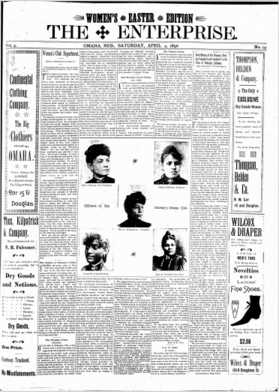George F. Franklin facts for kids
Quick facts for kids
George F. Franklin
|
|
|---|---|
| Born | February 1852 |
| Died | 1901 (aged 48–49) |
| Occupation | Journalist |
| Political party | Republican |
| Spouse(s) | Clara B. Williams |
George F. Franklin (born February 1852 – died 1901) was an important journalist and community leader. He lived in Omaha, Nebraska, and later in Denver, Colorado. He owned and published two newspapers for African-American communities. These were The Enterprise in Omaha and The Star in Denver. George Franklin also worked hard for civil rights. He was a member of the Nebraska part of the National Afro-American League.
Contents
Early Life and Family
George F. Franklin was born in February 1852 in Tennessee. He later moved to Texas, where his first child, William, was born in 1872. In 1878, he married Clara B. Williams. They lived in Denison, Texas, and had a son named Chester A. Franklin.
Chester later started his own newspaper, The Call, in Kansas City in 1919. Both Clara and Chester also wrote for The Enterprise and The Star. Clara was also a leader in Omaha's Colored Woman's Club. This club was led by Ella Mahammitt.
The Franklin family moved to Omaha in the mid-1880s. They later moved to Denver in 1898. While in Omaha, George Franklin was a trustee at St. John's AME church. In 1897, he opened a Real Estate and Rental Agency. George F. Franklin passed away in 1901.
Publishing The Enterprise
In 1889, Ferdinand L. Barnett started a newspaper for Black communities in Omaha called The Progress. A few years later, in 1892 or 1893, Cyrus D. Bell started the Afro-American Sentinel. Then, in 1893, George Franklin began publishing his own newspaper, The Enterprise.
These three newspapers sometimes had different ideas. The Sentinel supported the Democratic Party. After Booker T. Washington's famous 1895 Atlanta Compromise Speech, the papers reacted differently. The Progress did not agree with the idea of compromise. The Enterprise supported Washington's leadership. The Sentinel openly agreed with Washington's views.
The Enterprise continued publishing longer than the other two papers. When Franklin moved from Omaha in 1898, Thomas P. Mahammitt took over the newspaper. In 1896, another paper called The National Protest said The Enterprise was the "best colored paper published in Omaha." John Albert Williams also wrote for The Enterprise.
Community Involvement and Politics
George Franklin was very active in his community. In 1890, he helped create a special group to help Black families in Omaha buy or build homes. He was the president of this local group. Other leaders included William Marshall, Alfred S. Barnett, and James S. Bryant.
Franklin was also often involved in Republican politics in Omaha. He went to the State Republican Convention in 1889. He also attended many city and county Republican meetings. For example, he was part of the Republican county central committee in 1895. In both 1894 and 1895, Franklin was elected to be an assessor in Omaha's fifth ward. An assessor helps decide the value of property for taxes.
In 1896, he received support from the Omaha Colored Woman's Club. Its president, Ella Mahammitt, believed he was doing a lot for the Black community in Omaha. Franklin was then appointed to the position of Inspector of Weights and Measures by Mayor Broach. This job involved checking that scales and measurements were correct.
Working for Civil Rights
In the early 1890s, Franklin joined the Nebraska part of the National Afro-American League. This league was started by T. Thomas Fortune. In 1890, after some Omaha leaders attended the league's first national meeting, Franklin and others called for a meeting in Nebraska. They wanted to discuss equal rights and form a state league. They also wanted to help Black people move to Nebraska to buy homes and farms. In 1895, Franklin, Millard F. Singleton, and others were delegates from Omaha to the state meeting of this league.
In the mid-1890s, two legal cases involving Black men in Omaha gained a lot of attention. Supporters believed these men were wrongly accused. Attorney Victor B. Walker worked to help these men. George Franklin, along with Ella and Thomas P. Mahammitt, John Albert Williams, and others, played important roles. They helped gather support in the community for the people involved in these court cases.
Expositions and Community Representation
In the late 1890s, Black leaders in Omaha wanted to use big events to highlight the contributions of African Americans. These events included the 1897 Tennessee Centennial and International Exposition in Nashville and the 1898 Trans-Mississippi Exposition in Omaha. George Franklin, along with J. C. C. Owens, M. O. Ricketts, and others, helped organize these efforts.
They successfully sent a group to the Tennessee exhibition. They also made sure African Americans had a central presence at the Omaha exhibition. During the Omaha exhibition, many national Black organizations held meetings. Franklin was very involved in these meetings, including a Congress of Representatives of White and Colored Americans and a meeting of the National Colored Press Association.
The Star Newspaper
In 1898, Franklin and his family moved to Denver. There, he bought a newspaper called The Colorado Statesman. He changed its name to The Star. After George Franklin passed away in 1901, his wife, Clara, and son, Chester, continued to publish the newspaper.
Images for kids



